🎁 Free 30-day publishing fees on Pay-As-You-GO. Get 15% off when recruiting from the UserQ Panel, with code HELLO15
Human insights, Survey results
Survey insights on how people engage with digital content
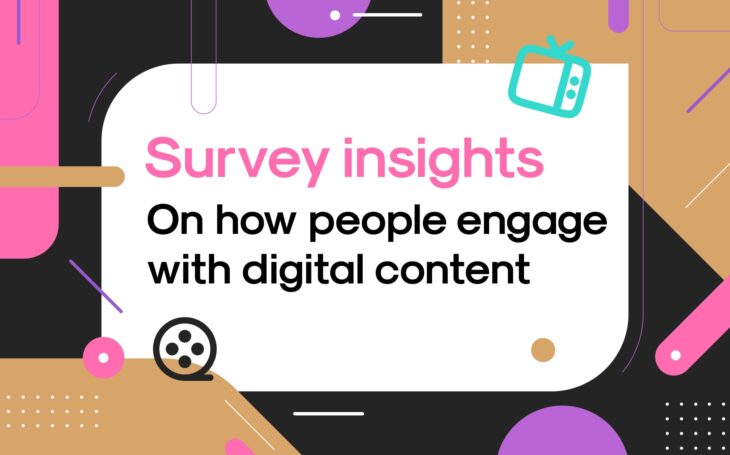
Navigating the digital content ecosystem: Key Insights for marketers
How do we engage with digital content today? How much time do we spend consuming it? What shifts have occurred in our content consumption patterns? What types of content are most preferred now, and how is the digital content landscape continuing to change? We dug deep with thorough research to get answers to all these questions. But before we dive into the details, here’s an interesting takeaway that shows how much things have changed between 2014 and 2024 regarding digital content. How have we evolved in the way we consume and engage with it? Let’s take a look!
“From January 2014 to 2024, the UAE experienced a monumental surge in social media users, witnessing an influx of more than 7 million new users into the digital arena. Notably, the year 2017 emerged as a pivotal milestone, with a staggering addition of 2.9 million new users within a single year. This surge was propelled by the meteoric rise of platforms such as TikTok, which captivated the imagination of millions and fueled a digital revolution that reshaped the social media landscape.”
Year | Users (In Million) |
Jan 2024 | 11.50 |
Jan 2023 | 10.73 |
Jan 2022 | 10.68 |
Jan 2021 | 9.84 |
Jan 2020 | 9.73 |
Jan 2019 | 9.52 |
Jan 2018 | 9.38 |
Jan 2017 | 9.20 |
Jan 2016 | 6.30 |
Jan 2015 | 5.40 |
Jan 2014 | 4.40 |
Fascinating isn’t it?
We wanted to explore what’s driving the rise in digital content consumption and how it has become a bigger part of our daily lives than ever before.
Here are a few key areas we focused on.
Device usage
Regarding devices used for consuming content, smartphones are the clear favourite, with 84.42% of respondents preferring them. Laptops are used by 36.36% of participants, highlighting the importance of mobile-optimized content and showing a significant role in desktop browsing.
What are the most popular topics people enjoy consuming as digital content?
Our survey identified a strong interest in several content topics:
- Technology: 76.62% of respondents ranked technology as their top interest.
- Health/Wellness, Travel, Food/Cooking, and Entertainment: All these topics received over 70% interest.
- Business/Finance, Lifestyle, Sports, and Education: These topics ranged between 50% to 70%.
Technology emerged as the most compelling topic, reflecting the growing importance of staying updated with tech trends.
What do you primarily consume digital content for?
Entertainment topped the list with 83.12%, followed by training and education at 66.23%. Participants also pointed out that digital content is widely consumed for motivation and inspiration, with 61.04% engaging for these reasons.
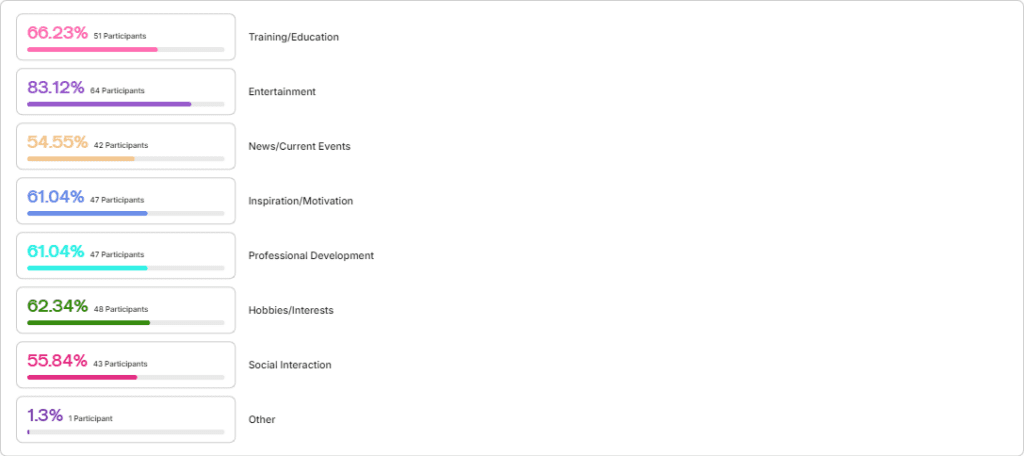
Which type of media do you prefer?
You know the answer – video content. Yes, with 96.1% video content was on top. Despite the dominance of video, written content remains popular, with 66.23% of participants choosing it. Image content ranks third, with 64.94% favouring it. Surprisingly, audio content, despite the rise of audiobooks and podcasts, trails behind with only 38.96% of the preference.

What do you primarily consume digital content for?
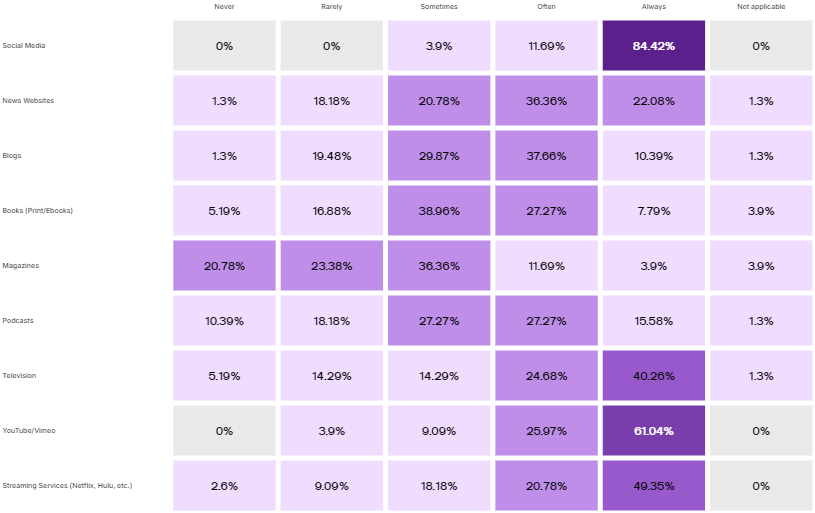
- Social media is the dominant platform for digital content consumption, with 84.42% of participants using it “Always”.
- Streaming services (Netflix, Hulu, etc.) show a strong preference for “Always” with 49.35% of participants.
- YouTube/Vimeo is widely consumed, with 61.04% of participants choosing “Always”
- Between 25% and 40% of participants “Often” engaged with content like blogs, books, and news websites.
How do you prefer to consume content?
In the era of TikTok, Instagram reels, YouTube shorts and now shopping apps too – it’s difficult to ignore short-form videos. Our participants also agree with an average score of 8.39 preferring short-form videos (Under 5 minutes). Although with a 7.45 average score, long-form videos are still in the game. Long-form articles came last with a 4.36 average score. The findings might lead you to think about attention span.
Did you know that as of July 2024, the United Arab Emirates was the country with the highest YouTube penetration, at approximately 94.1 percent. Understanding content consumption patterns has become crucial for marketers, product managers and agencies.
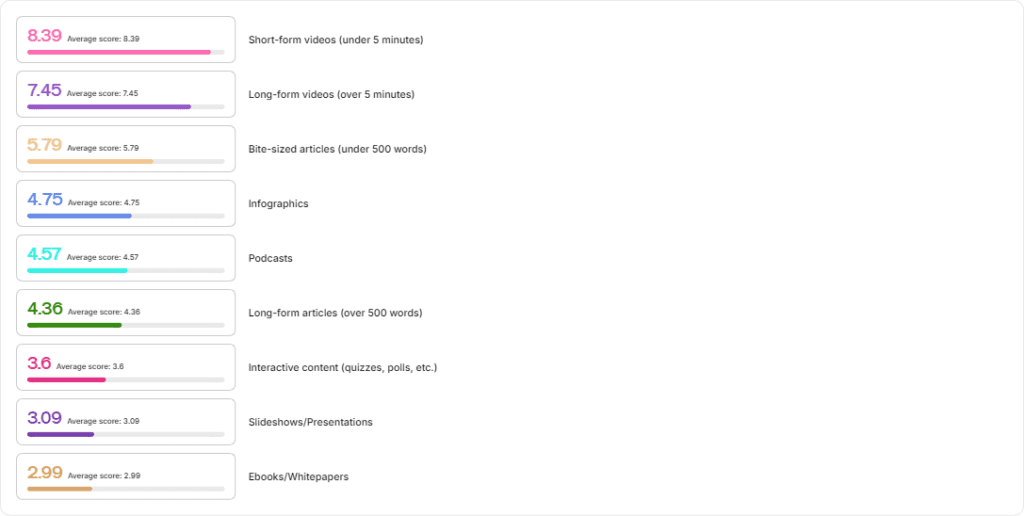
How important is the following in your content consumption?
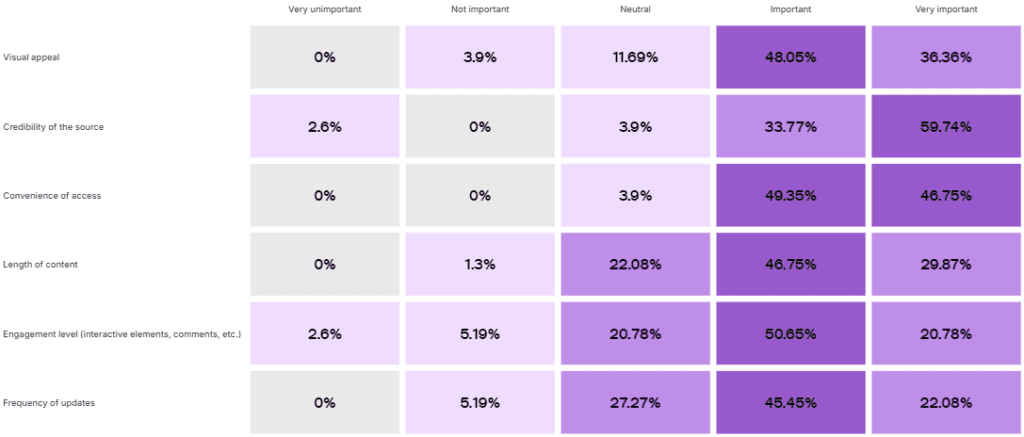
We live in an era where misinformation spreads rapidly via social media hence the credibility of sources remains crucial. In a recent survey, 59.74% of participants rated the credibility of sources as “Very important,” followed by the convenience of access. Additionally, 48.05% of participants considered visual appeal to be an “Important” aspect when consuming digital content. Interestingly, 50.65% of participants also viewed engagement level as an “Important” aspect.
How do you prefer to receive updates on your favourite topics? (Content consumption preferences)
Around 54% of the UAE population spends 6 or more hours on social media each week, with individuals under 24 years old allocating the most time. Specifically, 21% of this age group spends over 21 hours per week on social media.
In our recent survey, 44% of participants were male and 40% were female. The majority (51%) were aged between 26 and 35 years, with 16% falling into the 36 to 45 age range. Notably, 48% of participants reported spending more than 6 hours a day using devices. Our findings reflected the same information.
- Social Media: 85.71% prefer receiving updates through social media.
- Mobile App Notifications: 70.13% find them useful.
- YouTube Channels: 66.23% use this platform for updates.
- Email Newsletters: 40.26% prefer receiving updates via email.
Instagram and Facebook were identified as the most frequently used social media platforms, followed by TikTok and LinkedIn.
What time of day do you usually consume content? (Content consumption pattern)
Our survey revealed distinct patterns in content consumption:
- Time of Day: Most respondents (74.03%) consume content between 9 PM and midnight, with 70.13% also engaging in the evening from 6 PM to 9 PM.
How do you usually consume content? For example, what types of content do you prefer and when/where do you typically watch, read, or listen?
Respondents showcased a wide range of content consumption habits shaped by their interests and daily routines. The majority prefer watching videos on platforms like YouTube, Instagram, and TikTok, utilizing these for various purposes such as education, entertainment, and information. Short-form content, including reels and clips on mobile phones, is particularly popular for its time-saving benefits.
Many respondents also enjoy reading articles, news, and blogs on their mobile phones during early mornings and evenings. During work hours, laptops are the preferred choice for content consumption.
While some individuals mentioned other niche interests like politics, technology, finance, and culinary arts, these preferences still play a role in their content choices. Additionally, a smaller group of respondents prefers watching shows or movies on TV.
The diversity in content preferences highlights the multifaceted ways people engage with media, balancing between quick consumption on mobile devices and more in-depth interactions with longer content on other platforms.
Do you tend to share content that you find particularly useful, touching, or nice?
Sharing interesting content is a common practice among respondents. Approximately 33.77% of participants “Always” and 35.06% of participants “Often” share content they find useful or engaging.
How do you typically share content you find interesting? Please describe where you share it (e.g., word of mouth, social media, messaging apps, email) and with whom.
Respondents share content they find interesting through a variety of platforms, with social media being the most popular method. Platforms like Facebook, Instagram, Twitter, and TikTok lead in this space. Additionally, messaging apps such as WhatsApp, and direct messaging features on Snapchat and Instagram, are frequently used for sharing with close friends and family.
Participants exhibited diverse sharing habits: some prefer discussing content face-to-face or verbally (word of mouth), while others opt for sharing via social media feeds and stories. Less common methods include using emails and forums like Reddit for content sharing. Overall, social media and messaging apps remain the primary channels for distributing engaging content.
Conclusion
This survey provided essential information on consumer engagement, preferences, and patterns, allowing product managers, marketers, and agencies to refine their strategies to better meet consumer expectations. As you develop your digital content with your marketing team, use the findings from this survey to guide your approach. For further assistance in gaining actionable data and optimizing your strategy, reach out to the UserQ team.
Related Post
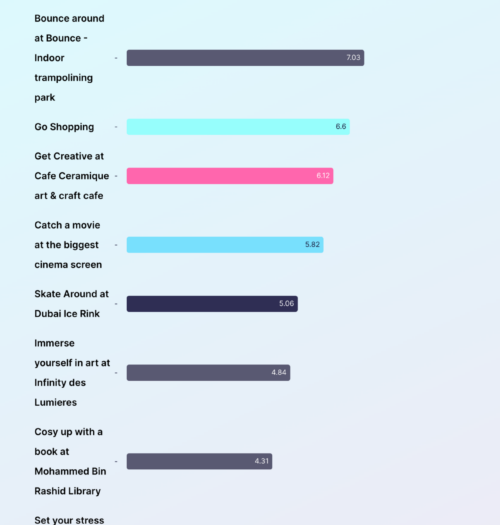
It’s raining in Dubai: Here
It’s raining in Dubai and we asked residents to rate their top inactivities (thanks to TimeOut Dubai) in order of

UserQ research: will a universal
The four-day working week has been a talking point here in the UAE for quite some time now. In fact,

The benefits of user research
User research is typically a key part of product development and business growth all around the world, but here at
Subscribe to our
product newsletter!
Receive emails about UserQ updates, new features,
offers and latest trends.


